Stanford d.school is the gold standard for all things experience, design, and honestly, cool. What do you expect when you combine smarts, engineering, meritocratic Groove-style culture, VC money, and graphics. So, it I was fairly delighted to find this 90 pg+ free pdf about design thinking called the d.school bootcamp bootleg deck here (2018). Think: Ideo on the cheap.
For consultants who have conducted 10+ executive workshops, and dozens of projects, you will see a lot of oldie-goldie tools in here. You’ll also appreciate how they approach these tools – much less linear, much more lateral thinking – that we decision-tree-driven engineering types think.
Namely, some of the hardest problems require some open space. Some problems require new, diverse, cross-functional membership. Some problems are not meant to be solved, rather embraced. Some problems need redefinition. Some problems are not problems.
Creative Commons
Already, they are thinking different from the monopolist. They are sharing. Think Seth Godin’s abundance mindset. Think Gary Vaynerchuk’s jab, jab, jab, right hook(affiliate link). Let me share first, then ask for something. These are their most used tools. All graphics from d.school files. An old one here and a new one here (2018). I will mix and match below.
5 Modes of Design Thinking
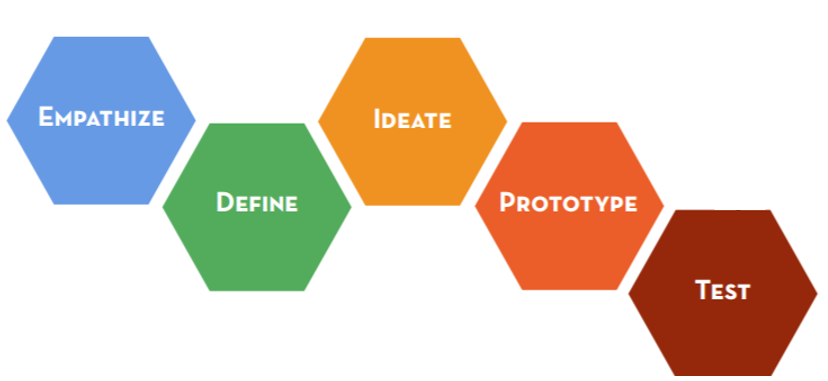
Empathize: Understand that it’s not about you. You are designing for someone else. BOOM. This is harder than you think – because we filter through our MBA-brains – and it’s actually hard to really SEE what the consumer / client is experiencing. Observe. Engage. Immerse.
(Loosely) Define: Narrow down the topic. Create a common baseline to work from by sketching out the edges of the puzzle. As the d.School says, “Understanding the meaningful challenge to address and the insights that you can leverage.” Caveat: traditional management consultants (read: me) will make this too MECE, too constricted, too robotic. Remember, this is still early in the process and efficiency is not the goal.
Ideate: Generate a lot of diverse, radical, and who-would-have-thought-of-it solutions to the challenge. Move beyond the obvious solutions. Know when you are generating ideas (good) and evaluating ideas (not now).
Prototype: Bring all the talky-talk to life with a physical sample, visualization, storyboard, drawing, or soundtrack. Extract it from the thought-bubble to something material. Yes, you are testing functionality, but also 1) learning 2) solving disagreement 3) starting a conversation 4) failing cheaply 5) breaking the problem into smaller parts for solution-ing.
Test: This is the yin/yang of prototyping. Learn about the user, refine the prototype, refine your Point of View. (Namely, is there a willingness to pay?)
7 Design Mindsets
The d.school summarizes so well below:
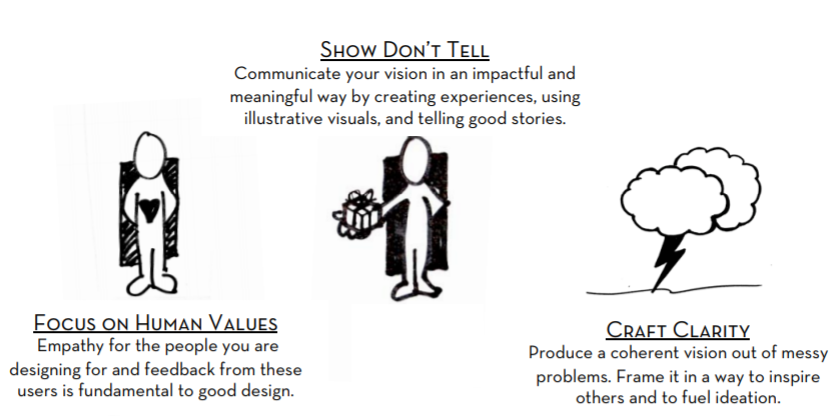
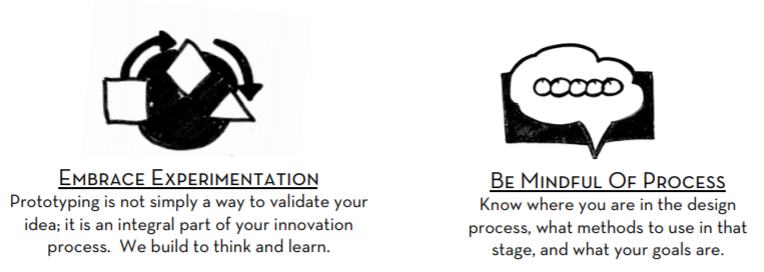
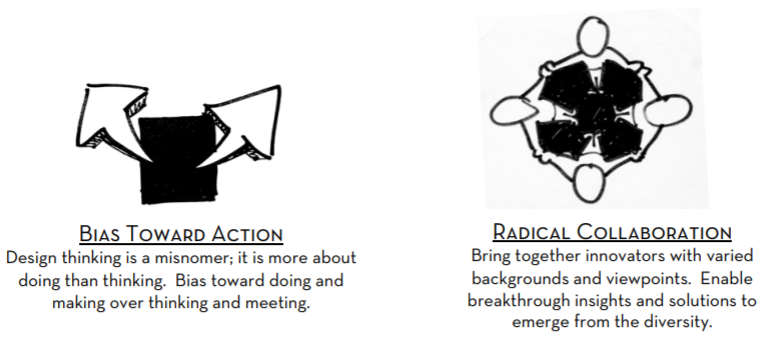
List of 30+ Design Tools
Assume a beginner’s mindset – Tom Kelley – IDEO – said it best in 2008; think like a traveler here.
What, How, Why – Using photographs and videos shot during observation, move from the concrete (What you see in the photos) to the emotional (Why you think they are doing this).
User camera study – Super document the experience from the vantage point of the user. When hospital consulting, we would often have someone play the role of the patient and get rolled through the emergency department (from the ambulance, through triage, to the bays) (hat tip: AP).
Interviews – Consultants do this all the time. Some good generic tips here, Design-oriented interviews emphasize emotional connections and stories. Asking the interviewee “why”. This will become ingredients for design.
Extreme users – Examine the edges of the distribution. Identify your super-users and see how they interact with your products/services. Do they have work-arounds that you should make standard?
Saturate and group – Collect copious input, drawings, observations – then stratify into buckets. Consultants excel and breaking it down into processes, or stakeholders, or functional areas.
Empathy map – What do users 1) Say 2) Do 3) Think 4) Feel? List them out, and reflect on the needs (verbs). For the marketer: “When does the user’s words not match their actions?” Seth Godin echos this idea here.
Journey map – What does the user’s journey look like? Activities, sequences, timeline, interactions, emotions, environment, etc. For a process consultant: “Where does the process slow down?” For the marketing consultant: “What does the user disengage, and abandon the purchase?”
Composite character profile – What’s the user’s personna? Marketers: think STP (segmentation, targeting, positioning). There is no such thing as average. “Average gross margin” is a myth. Work with specifics.
Powers of ten – Be willing to use the elements of exaggeration to test the assumptions underlying a process. What if it cost $1M, not $100? What if this had to be done in 24 hours, not 3 months? This “flares” the discussion towards more radical ideas, trade-offs, and outcomes. Basically, more fun.
2 x 2 matrix – Consultants LOVE 2×2. Founder’s Mentality. BCG Growth Matrix. SWOT. The list goes on and on.
WHY-HOW laddering – The premise is to ask Why questions to elevate the customers need (usually higher-level, more abstract, Maslow’s hierarchy) and How questions to narrow down to more specific tactics. This may be a better version of the 5 Why’s that operations consultants often learn; this one lets you get more general and more specific (Why vs. How).
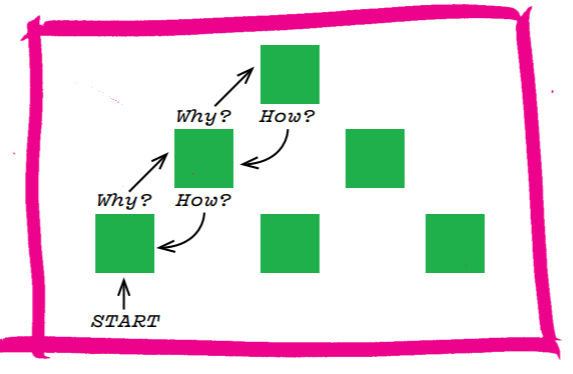
Point of View – According to d.school, “A point-of-view (POV) is your reframing of a design challenge into an actionable problem statement that will launch you into generative ideation.” This can take the form of a Mad Lib. [User] needs to [User’s need] in order to [Insight]. Or this can be a fictitious scenario where the user posts a want-ad for something.
POV checklist – “Use this Checklist to ensure that your team’s POV is valid, insightful, actionable, unique, narrow, meaningful, and exciting.” This has a series of 4 questions: 1) What’s the point 2) Who says 3) What’s new? 4) Who cares? This is probably the most important point – read for yourself on page 27 of the old d.school workbook here.
Design principles – These are imperatives to guide the design. What are guardrails in the design process? What do we want to make sure happens? Sometimes, the WAY of getting to the output is just as important.
How might we? – These short questions create the seeds for brainstorming. They “fall out of the point-of-view, design principles, or insights” according to the d.school. As a facilitator, the art is choosing “How might we . . . ” questions which are not too broad or narrow. Great examples on page 29.S
Stroke (Energy Up) – Get the energy of the room UP. Throw a ball. Improv. Category, category, die! (Go in a circle, name something in the category, keep rotating until someone misses it, then they are out)
Yes, AND – As with improv, take what someone said/thought and build on it.
Brainstorm facilitation – Create an environment where people offer wild, wide-ranging ideas. Get Headlines. Whiteboard. Make it visual with drawings. Facilitating this is a craft. Keep the teams “on-topic” and yet, don’t judge or rule-out ideas. Go for quantity. THEN, only THEN, group them.
Brainstorm selection – Key point: don’t narrow down too quickly. A few ways to legislate: 1) voting, people put dots on their favorites 2) four category method: rational choice, darling choice, delightful choice, long-shot. Caveat: this is where the facilitator has enormous power to influence the breadth of choices, architecture of choice, and favored outcome.
Bodystorming – just like it sounds.
Add constraints – It’s counter-intuitive, but deliberately adding constraints can help increase creativity. “What if you had to build it for under $100?” “What if it were for the blind?” “What if all the instructions had to be pictures.” “What if you only have 2 hours to complete it?”
Prototype for empathy – Prototyping is a core activity of design work – and very different from traditional measure-twice-cut-once approach to product design. Earlier in the process, you can prototype to generate reactions / evoke MORE empathy as an ingredient to the process.
User testing – Let the user try out your prototype. What’s their reaction?Let them talk it out. Ask follow up questions. Think Agile development. Other variants: Wizard of Oz prototyping, User-generated prototyping.
Identify (and test) a variable – Understandably, you cannot test everything. Make trade-offs and determine what parts need testing. “Prototype with a purpose” extols the d.school.
User Feedback – Feedback is gold for the consultant. In the diagram below, what is great (+) constructive criticism(delta), questions(?), and new ideas?
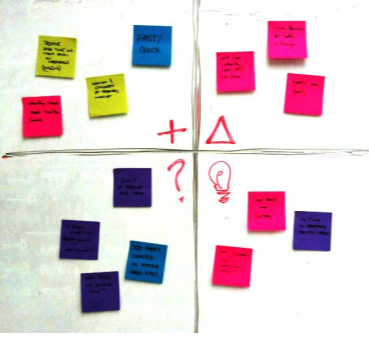
Storytelling – Everything is storytelling.
Innovation portfolio – As with any portfolio, you need to know what you have and continually prioritize. What’s disruptive (Clayton Christensen) and what’s sustaining innovation? What’s a shallow vs. deep insight?
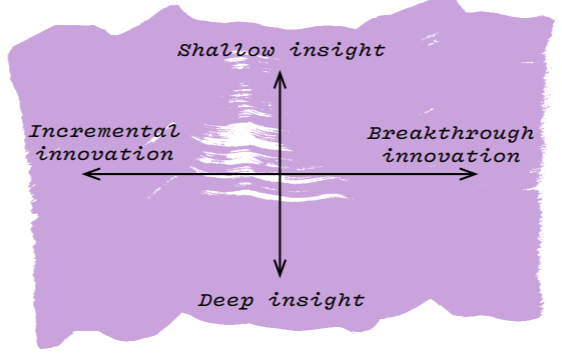
Finally, here’s a 6 page summary of how you can run a design session yourself here. Thank you d.school. Solid work.

